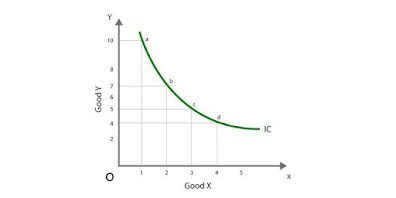Indifference Curve Definition
Indifference curve is a graphical
representation of a combination of products that gives a consumer a similar
level of satisfaction and renders them
indifferent. Every point on the indifference curve indicates that a person or
consumer has no preference between the two goods because they provide him with
equivalent utility.
In economics, the indifference curve investigates demand patterns for commodity combinations, budget constraints, and customer preferences. The theory applies to welfare economics and microeconomics, such as consumer and producer equilibrium, consumer surplus measurement, the theory of exchange, and so on.
Indifference Curve Assumptions
• To maximize satisfaction, the consumer is rational and makes a
transitive or consistent choice.
• The consumer is expected to purchase any combination of the
two commodities.
• Customers can rank a variety of commodities based on their
level of satisfaction. Typically, the combination with the highest level of
satisfaction is preferred.
• In the analysis, consumer behaviour remains constant.
• The utility is represented by ordinal numbers.
• Assumes that the
marginal rate of substitution will decrease.
Indifference Curve Criticisms
(1) Indifference Curves are
Non-transitive:
W.E. Armstrong is a leading critic of the indifference hypothesis, arguing that the consumer is indifferent not because he has complete knowledge of the various combinations available to him, but because of his inability to judge the difference between alternative combinations. He also believes that any two points on an indifference curve are points of indifference not because of iso-utility difference, but because of zero-utility difference.
(2) The Consumer is not
Rational:
The
utility theory, like the indifference analysis, assumes that the consumer acts
rationally. He has a calculating mind and can carry innumerable combinations of
various commodities in his head, substituting one for the other, comparing
their total utilities, and making a rational choice between various
combinations of goods. This is too much to ask of a consumer who must act
within a variety of social, economic, and legal constraints.
(3) Combinations are not based
on any Principle:
Because
the combinations are made regardless of the nature of the goods, they
frequently become absurd. How many of us buy ten pairs of shoes and eight pairs
of pants, six radios and five watches, or four scooters and three cars? Such
combinations have no relevance for the consumer.
(4) Limited Analysis of
Consumer’s Behaviour:
Furthermore, the assumption
that consumers buy more units of the same good when its price falls is
unfounded. Aside from the case of inferior goods, he may not want to have more
units of a good because he is influenced by "conspicuous consumption"
and desires to display or have variety. Changes in the consumer's tastes, as
well as his indulgence in speculative purchases, influence his preference for
the goods. Because of these exceptions, indifference analysis is a limited
study of consumer behavior.
(5) Away from Reality:
According to Prof. Robertson, "the fact
that the indifference hypothesis, the more complicated of the two
psychologically, also happens to be the more economical logically, provides no
guarantee that it is closer to the truth." He then asks if we can disregard
four-footed animals on the ground because walking only takes two feet.

Comments
Post a Comment